THE GARDEN AT THE EDGE: Crossing Hegel’s Stile
© 2011 Roy Nicholson
At Stonypath or Little Sparta, Ian Hamilton Finlay’s garden in Scotland, the artist/gardener has created a work that goes to the heart of the issue of edge. What separates the garden from its surroundings? How can we pass from one area to another and how can we confine animals or people to certain places? When a fence defines the border a gate becomes its opposite. Finlay expressed this dichotomy with the words thesis, fence; antithesis, gate, in beautifully carved script on the fence post. He then created a synthesis by building a stile that allows entrance to the enclosed space without breaching its perimeter. He titled the work (below) Hegel’s Stile in acknowledgement of Hegel’s philosophy that every postulate (thesis) evokes its natural opposite (antithesis), and that these two result in a unified whole (synthesis), which in turn reacts upon the original thesis.[1]
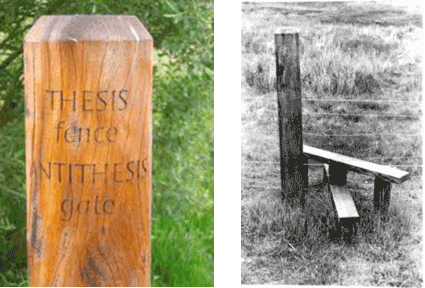
Both paintings and gardens can be repositories of ideas about synthesis, mediation and reconciliation, and the artist/gardener has to be fully aware of such issues. In a discussion of the meaning of the pastoral (that idealized place where shepherds live with their flocks, in harmony with nature), the historian of the American landscape, Leo Marx, writes: “This pastoral interpretation of the mental map is traceable to the idealization of the ancient Middle Eastern herdsman and to his role as a mediating, or what the anthropologist Victor Turner called a liminal (from the Latin limin, or “threshold”) figure, one whose calling required him to work in the borderland between civilization and nature.”[2]
Finlay himself, like many artists, often occupies a position that places him in the threshold position. His battles with authority are legendary and his garden is the battlefield. “Certain gardens are described as retreats when they really are attacks,”[3] he wrote.
The reconciliation of opposites, the passing from one zone to another, whether in the mind or on the land, and the character of the transition point are situations that give us metaphors that can be applied to both gardening and art. Throughout this paper I will deal in various ways with borders, both as terminal points and as enclosures, and examine how they function in art and the garden.
In John Vernon’s book, The Garden and the Map, humankind’s separation from nature in Western thought is described as schizophrenic. It must result in a struggle between the civilized and the savage. The world is split into subject and object, allowing us to control and manipulate nature. Vernon questions the whole idea of sanity. For him “genuine madness . . . is the sanest response to the world, for it is that in which body, self, and world are united. This unity penetrates all the coordinates of experience; it means that subject and object, fantasy and reality, and savagery and civilization are all one in a unity of plenitude and wholeness, in a becoming, fully open, erotic world. This is the ecology of human existence, the underlying interdependent structure upon which our very sanity–and survival–depends.”[4] My 1995 painting, also entitled The Garden and the Map (below), expresses this duality by showing garden plan and perspective views embedded in a synthetic amalgam of cultivated and wild elements.
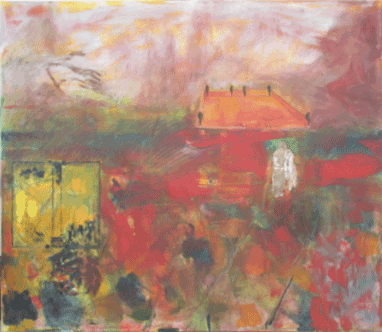
The Edge of the World
According to Leo Marx’s book, The Machine in the Garden, as Europeans became aware of the unspoiled New World, they began thinking of it as a kind of pastoral ideal.[5] Columbus reported that his ship had circled the very nipple of the “cosmic breast”–paradise itself.[6] Over three hundred years later Thomas Jefferson, when formulating ideas about the government of the fledgling United States, looked to Virgil for a basis of a new Republic based on the ancient pastoral concept. This sense of an ideal place persists in the “American Dream.” The steady movement of people from the cities to suburbs implies the possibility of an oasis of calm in a pastoral setting. Clinging to that notion, people have been pushing farther and farther into the wildest parts of the country, but instead of creating Arcadia they produce ecological disaster. Problems arise when excessive development of the land causes the pastoral ideal to be no longer balanced between nature and civilization.
The English philosopher John Locke said in his Second Treatise on Civil Government (1690) that for something, including land, to have value, it had to be incorporated into an economy. Since America was so vast and had no viable way to get goods to and from its interior spaces, it had no economy. In spite of its fertile, habitable land there was therefore no value incorporated into it.[7] This is clearly not the case now that technology enables people to live where they wouldn’t have in the past. However, for the Puritans, whose definition of nature and natural, according to Leo Marx, was that which existed in a fallen state, the Biblical injunction to subdue the earth was something to be taken seriously.[8] Therefore conquering nature or the wilderness became a strong force in the “civilizing” of America.
Space without artificial borders is essential to the vision of America as a paradise. It was not until the middle of eighteenth century that the concept of the sublime would allow people to see God’s presence in the awesome vistas of uncultivated spaces, as in this 1886 painting by Albert Bierstadt, Sunset in the Yosemite Valley.
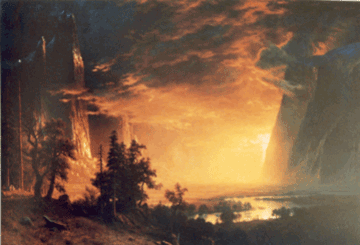
This idea originated with Edmund Burke and the Reverend William Gilpin in England and was clarified by Kant, who, according to Andrew Wilton, suggested that the sublime was characterized by boundlessness while the beautiful, dependant on form, naturally resulted from the presence of boundaries. We now think of England’s Lake District as having a distinct boundary, but it was considered unbounded in 1797 when Turner created his sublime images of the area. I wonder how he would have reacted to Yosemite, a vastly larger and more awesome place than the Lakes.
This attitude, embodied in people who want the wilderness preserved, and its opposite, embodied in those who feel that the land has to be conquered, give us two poles between which the garden sits uneasily.
In his article, “American Space,” Roderick Nash writes of Henry David Thoreau confessing to being lonely and afraid in the presence of “vast, Titanic, inhuman Nature.”[9] To quote Nash: “The wilderness stripped him of his transcendental confidence in the innate divinity of both man and nature. The link between wildness and culture no longer seemed as simple as it had on the edge of Walden Pond in what was, essentially, suburban Boston. Civilization, he concluded, was not irrelevant to culture . . . The ideal condition was one that blended wilderness and civilization or, as Emerson put it, society and solitude.”[10]
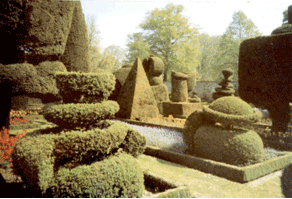 The Feathered Edge
The Feathered Edge
In his 1712 essay, “Pleasures of the Imagination,” in the Spectator, Joseph Addison complained about the rigidity of English gardens, such as Levens Hall, laid out in 1692 (above).
Addison rejected the formal, geometric, English style in favor of the more “natural” styles of Italy and France. In those countries, he said, “we see a large extent of ground covered over with an agreeable mixture of garden and forest, which represent every where an artificial rudeness, much more charming than that neatness and elegance which we meet with in . . . our own country.”[11] Addison applied his idea to a greater and greater area of the land, until he seemed to be talking about the rural scene as if it were one vast garden.
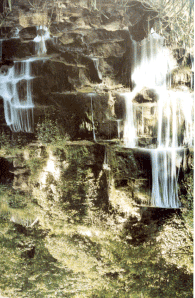 The English garden Addison complained about was essentially artificial. It referred to the Greeks via the history of the Italian garden to make complex political and cultural statements that often paralleled those of the other beaux-arts, which attempted to impose manmade order on nature’s chaos. By mid-century, however, attitudes were changing. Beginning with the garden designer William Kent in the 1740’s and continuing with Lancelot “Capability” Brown, the English garden underwent a continual process of naturalization, to the point where it became difficult to distinguish between the wild and the cultivated. An example is the cascade at Boxwood House (above), designed by Brown in 1757.
The English garden Addison complained about was essentially artificial. It referred to the Greeks via the history of the Italian garden to make complex political and cultural statements that often paralleled those of the other beaux-arts, which attempted to impose manmade order on nature’s chaos. By mid-century, however, attitudes were changing. Beginning with the garden designer William Kent in the 1740’s and continuing with Lancelot “Capability” Brown, the English garden underwent a continual process of naturalization, to the point where it became difficult to distinguish between the wild and the cultivated. An example is the cascade at Boxwood House (above), designed by Brown in 1757.
This move from the artificial to the natural resulted in an art that became increasingly self-referential, foreshadowing a similar process in the much later development of Modernism. The lines of demarcation became blurred, and as John Dixon Hunt wrote in “The Garden as Cultural Object:” “By using natural forms to represent English nature, the English landscape garden defeated its ambition to be a representative art. The medium was the message, and nobody could tell them apart.”[12]
In a sense the garden can be considered to be a kind of buffer zone between the geometry of the built environment and the organic character of nature. As Hunt points out, two Renaissance writers, Jacobo Bonafidio and Bartolomeo Taegio, introduced the concept of the garden as a “third nature” (terza natura), resolving the ancient conflict of art (cultivation) and the wilderness.[13] This is not unlike the idea that the pastoral is a mediation between civilization and nature and refers to Virgil, who sketched an ideal landscape surrounded by an alien world that encroaches from without. Leo Marx refers to the via media, a “middle landscape” that is neither urban nor wild. The garden can be a place of blurred distinctions, with an enriching flow between the wild and the cultivated. Vernon, in The Garden and the Map, also describes the garden as a place where opposites can co-exist.
The Environmental Edge
As John Beardsley writes in Earthworks and Beyond, “Americans are afflicted with a profound ambivalence toward nature, manifest in a seemingly irresolvable conflict between the impulse to exploit the landscape with ever more sophisticated tools and the urge to nurture and protect such little as is left of the natural world, not only for its beauty, but also for its morally and spiritually uplifting effect.”[14]
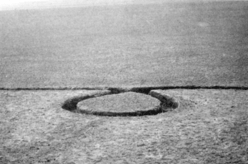 Artists who deal with the land itself, the so-called, “earth artists” or “environmental” artists, also take positions at opposing poles. On the one hand, artists such as Michael Heizer (whose 120x12x1 foot Isolated Mass/circumflex, #9, of Nine Nevada Depressions, 1968, Massacre Dry Lake, Nevada is shown at right), Walter De Maria and Robert Smithson have created art that exploits the land, while artists like Richard Long,
Artists who deal with the land itself, the so-called, “earth artists” or “environmental” artists, also take positions at opposing poles. On the one hand, artists such as Michael Heizer (whose 120x12x1 foot Isolated Mass/circumflex, #9, of Nine Nevada Depressions, 1968, Massacre Dry Lake, Nevada is shown at right), Walter De Maria and Robert Smithson have created art that exploits the land, while artists like Richard Long,
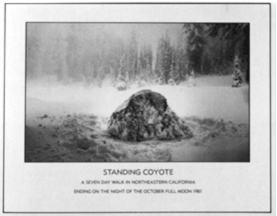 Alan Sonfist, Andy Goldsworthy, David Nash and Hamish Fulton (Standing Coyote, 1981, left), work with sensitivity toward the environment.
Alan Sonfist, Andy Goldsworthy, David Nash and Hamish Fulton (Standing Coyote, 1981, left), work with sensitivity toward the environment.
When asked by interviewer Michael Auping for an opinion on the work of Smithson, Heizer and De Maria, Fulton replied, “I feel the three artists you mention use the landscape without . . . any sense of respect for it . . . . I see their art as a continuation of ‘Manifest Destiny’. . . the so-called ‘heroic conquering’ of nature. My art is a passive protest against urban societies that alienate people from the world of nature.”[15]
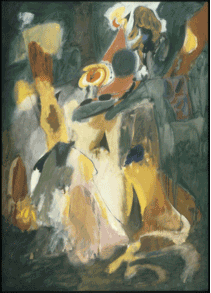 Other artists, such as the painter Arshile Gorky, (whose Waterfall, 1943, is at right) can find inspiration in the complexity of the conflict between civilization and nature. In a letter of November 24, 1940, he wrote:
Other artists, such as the painter Arshile Gorky, (whose Waterfall, 1943, is at right) can find inspiration in the complexity of the conflict between civilization and nature. In a letter of November 24, 1940, he wrote:
The artist cannot avoid nature and his return to it should not be equated with primitivism but instead a reevaluation of nature based on the new experiences perceived through the complexity of civilization. It is better to be conscientiously troubled and perplexed by the vastness of the unknown, than content with the little that is known. Civilization knows more about complexity whether or not it has been able to solve the problems of it. And this is the key to the advancement of aesthetic art. Perceiving nature through the eyes of civilization brings to great art more authority and strength. Mastery of complexity involves the experience of complexity. It is this clash of opposites, of new and different ideas and experiences that is so important in advancing great art.[16]
For Gorky, there appears to be a meeting place between the poles of the two positions that treat America as either a wilderness to be preserved or a large patch of real estate to be divided up and allotted monetary value. Balance is the essence of the pastoral, which is a state between nature and civilization. To regain the balance could be a function of the artist; but even in the so-called environmental art movement we see the two opposing poles previously described.
The Inserted Edge
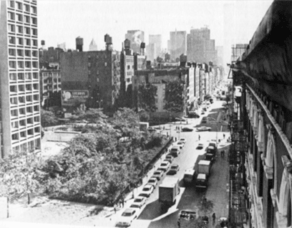 In an interview with Alan Sonfist[17] he and I discussed what happens when art becomes inserted into the natural environment. He drew parallels between painting and his own work. “Freedom of interpretation becomes like a palette to interpret the landscape,” he said. “My early landscapes were rectangular, [going] back to the slice within the overall environment . . . You realize that this painting/landscape ends at that point and the contemporary landscape continues. You have to consciously think about edge. Maybe that comes from my art training, . . . defining the relationship of the environment to the edge. The sites I am working on are a given. I can’t move the landscape around from place to place like a painting, and so the edges become very crucial to the actual types of plants that I use.” Sonfist went on to describe the importance of arranging plants according to their needs. For example, he planted oak trees on the shady side of his 1965 work, Time Landscape (above), in Manhattan because he knew that the surrounding buildings would act as a kind of forest by throwing shadows over the saplings for half a day, as mature trees would in a forest. Sonfist’s awareness of the interaction between his work and the place beyond its boundary is keen. In a work commissioned by the Auckland Art Museum in New Zealand, the piece itself sits on the edge between two different environments. The work defines the point of transition between a park and a dune area on the seashore, and consists of a gateway made of bronze castings of driftwood and endangered trees. People are directed to the gate by changes to the park topography and pass through to the beach without trampling the fragile area of the dunes.
In an interview with Alan Sonfist[17] he and I discussed what happens when art becomes inserted into the natural environment. He drew parallels between painting and his own work. “Freedom of interpretation becomes like a palette to interpret the landscape,” he said. “My early landscapes were rectangular, [going] back to the slice within the overall environment . . . You realize that this painting/landscape ends at that point and the contemporary landscape continues. You have to consciously think about edge. Maybe that comes from my art training, . . . defining the relationship of the environment to the edge. The sites I am working on are a given. I can’t move the landscape around from place to place like a painting, and so the edges become very crucial to the actual types of plants that I use.” Sonfist went on to describe the importance of arranging plants according to their needs. For example, he planted oak trees on the shady side of his 1965 work, Time Landscape (above), in Manhattan because he knew that the surrounding buildings would act as a kind of forest by throwing shadows over the saplings for half a day, as mature trees would in a forest. Sonfist’s awareness of the interaction between his work and the place beyond its boundary is keen. In a work commissioned by the Auckland Art Museum in New Zealand, the piece itself sits on the edge between two different environments. The work defines the point of transition between a park and a dune area on the seashore, and consists of a gateway made of bronze castings of driftwood and endangered trees. People are directed to the gate by changes to the park topography and pass through to the beach without trampling the fragile area of the dunes.
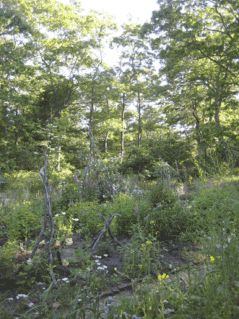 My own garden is surrounded by trees that cast varying shadows according to the time of day and the season (left). The shade that reaches across the edge gives constant interest and variation in light and texture, but also has to be taken into account when considering the plantings. Sonfist has made this an issue in one of his most recent landscapes, in Tampa, Florida. He has utilized the shadow patterns thrown by buildings in the downtown area and made a corresponding silhouette in tile in the area of the artwork. The piece consists of a series of stages that move from the city buildings through an orange grove planted with the latest in drought-free grasses to the edge of a re-created mangrove swamp. Very much like “Capability” Brown, the eighteenth century English landscaper and one of Sonfist’s heroes, he leads the viewer from the cultivated to the edge of the wild and back again. One of Sonfist’s greatest concerns is to create a sense of the history of a particular place. In Time Landscape, he planted indigenous trees, such as oaks, that had existed in pre-colonial times. By doing this, he also created an ironic reversal of the flight to the suburbs by contrasting the small forest with the urban environment of Manhattan. Civilization, as represented by the street grid system, surrounds the wildness of the woods that, ironically, has to be protected by a chain link fence. According to Sonfist, “we as humans have separated ourselves from our environment, and the ironic part [is that] we are part of it. Cultivated versus natural are both natural systems. In this day and age it is very important to insert, especially in the urban and suburban environments, what I call historical nature, which of course has been obliterated by human evolution in the cities. [There needs to be] a balance between historical nature and contemporary nature in the cities.”
My own garden is surrounded by trees that cast varying shadows according to the time of day and the season (left). The shade that reaches across the edge gives constant interest and variation in light and texture, but also has to be taken into account when considering the plantings. Sonfist has made this an issue in one of his most recent landscapes, in Tampa, Florida. He has utilized the shadow patterns thrown by buildings in the downtown area and made a corresponding silhouette in tile in the area of the artwork. The piece consists of a series of stages that move from the city buildings through an orange grove planted with the latest in drought-free grasses to the edge of a re-created mangrove swamp. Very much like “Capability” Brown, the eighteenth century English landscaper and one of Sonfist’s heroes, he leads the viewer from the cultivated to the edge of the wild and back again. One of Sonfist’s greatest concerns is to create a sense of the history of a particular place. In Time Landscape, he planted indigenous trees, such as oaks, that had existed in pre-colonial times. By doing this, he also created an ironic reversal of the flight to the suburbs by contrasting the small forest with the urban environment of Manhattan. Civilization, as represented by the street grid system, surrounds the wildness of the woods that, ironically, has to be protected by a chain link fence. According to Sonfist, “we as humans have separated ourselves from our environment, and the ironic part [is that] we are part of it. Cultivated versus natural are both natural systems. In this day and age it is very important to insert, especially in the urban and suburban environments, what I call historical nature, which of course has been obliterated by human evolution in the cities. [There needs to be] a balance between historical nature and contemporary nature in the cities.”
The fence around Time Landscape represents the point of change between one set of systems and another, what ecologists term the Tension Zone or Ecotone, an area of enhanced interaction where more species exist than in either of the other two discreet territories. Areas at the edge of the ocean, such as the intertidal zone, can support many forms of fauna, except for some amphibians, and have what is called a recruitment effect, or edge effect, that is an enhancing force on the inhabitants of that habitat.[18]
The edge plays an important role in all types of human activity. This is particularly true in painting, an art form that for hundreds of years has addressed the issue of human interaction with nature. Edges are places of tension. Vibrations can be set up between two colors to give an energetic effect where none existed before. Form can be differentiated from form by the creation of borders. Figure and ground are separated by edge. The work itself is separated from its surroundings by its frame. In the creative act itself borders are crossed between the conscious and the subconscious and the interplay between the two gives us our richest experiences.
The Urban Edge
Marcel Proust shows how context is so important by writing, in Cities of the Plain, that “a little slice of garden with a few trees, which would seem shabby in the country, acquires an extraordinary charm in the Avenue Gabriel or let us say the Rue de Monceau, where only multimillionaires can afford such a luxury . . . ”[19] This is the luxury of Sonfist’s primal forest in the city, or any of the park or garden-like spaces that provide respite from the relentlessly urban. Edges become very well defined in the city, especially in the grid of New York. Sonfist’s Time Landscape has its chain link fence. A stone wall and city streets define Frederick Law Olmstead’s Central Park. In 1982, artist Agnes Denes (below) planted a wheat field on Manhattan’s Battery Park that called attention to the difference between the urban and the agricultural environment.
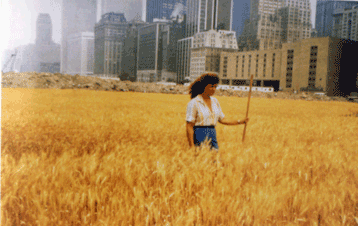
High buildings and walls surround many of the small parks and some of the garden spaces have even moved indoors. Dan Kiley, a landscape architect, with Kevin Roche and John Dinkeloo, designed a large interior garden court for the Ford Foundation Building in New York that included full-size trees. Not only does this garden have a particularly strong border at the edges but it also has a ceiling that defines its upward limitations. Gardens can also be high in the air, clinging to the tops of buildings and surrounded by walls that separate people from a distance from earth not normally associated with gardens.
A Particular Edge
In the garden the most important edge is its border. At this point there can be considerable interaction between the cultivated and the wild. In my own garden (below), a cultivated space has been inserted into woodland.
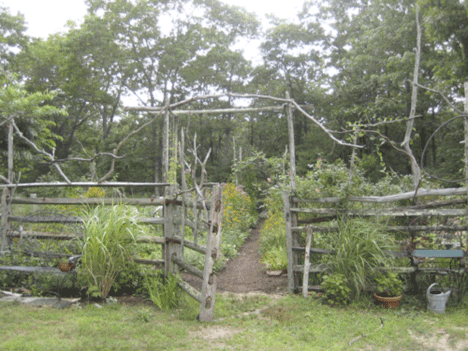
Once established, it became an oasis to be visited. Flycatchers, bluebirds, and dragonflies came to linger and raise young. Butterflies sought out nectar and of course deer came to feed on the roses. If I look closely at the edge of the garden,
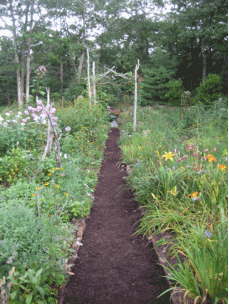 I find that grasses that had been dormant for years have sprung up and are moving to the inner parts of the space.
I find that grasses that had been dormant for years have sprung up and are moving to the inner parts of the space.
I have planted dogwood trees in the grasses. Some of the trees are indigenous species and therefore closer to the historical landscape, while Kousa dogwoods are exotics that are more likely to survive disease. The soil has had to be imported and created from compost, but at the edge it is mixed. It is a good place for plants that are both wild and cultivated such as Digitalis. I have made paths (above) to give definition to the space which, at the edge, rises in a spiral ramp to a seated overlook.
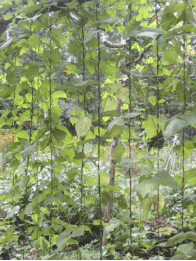 I have constructed an arbor in the cultivated part of the garden. It is cloaked in runner bean vines in the summer (right), and as a source for several of my paintings it represents all manner of structures, from the rustic to the architectural. It is a trigger for ideas such as transparency or concealment, mystery, shelter, growth, containment, fragility, moving through, and so on.[20]
I have constructed an arbor in the cultivated part of the garden. It is cloaked in runner bean vines in the summer (right), and as a source for several of my paintings it represents all manner of structures, from the rustic to the architectural. It is a trigger for ideas such as transparency or concealment, mystery, shelter, growth, containment, fragility, moving through, and so on.[20]
The Painted Edge
It seems that the old conflict between representation and the non-objective is much less important in painting now. At least in my own work, like my painting Cadmium Mist, 1996 (below), I feel that I can draw on both traditions at the same time and the resulting paradoxes are productive.
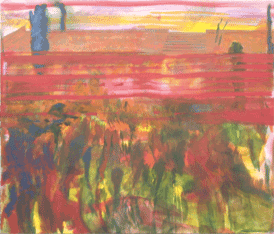 The art historian Arnold Hauser (who was my art history teacher at art school) maintained that the abstractionists who followed Jackson Pollock’s example could make paintings presenting opposites that are apparently irreconcilable.
The art historian Arnold Hauser (who was my art history teacher at art school) maintained that the abstractionists who followed Jackson Pollock’s example could make paintings presenting opposites that are apparently irreconcilable.
In a discussion of the concept of the discordia concors (harmonious discord) paradox, Donald Kuspit quotes Hauser’s contention that such an approach does not signify
that each statement is the retraction of the last, but that truth inherently has two sides, that reality is Janus-faced, and that adherence to truth and reality involves the avoidance of all oversimplification and comprehending things in their complexity.[21]
If we imagine the garden as a metaphor of that duality, we can see it representing abstraction while at the same time manifesting itself concretely. It can include the wild and the tame. It can incorporate aspects of garden design history from all over the world. As a microcosm of Arcadia, the American garden and American painting can be based on the idealized condition of native raw materials shaped and ordered by imported ideas and systems.
In painting, the coexistence of opposites is not only possible but essential. They help to distinguish one form from another. It is important to establish foils so that images, shapes and meanings can be realized.
Both painting and gardening are activities of the imagination. Addison located the imagination in the middle position between the brutish senses and the abstract intelligence,[22] again, a place of transition. Fences—like the one surrounding my own garden, below—are important clarifiers of where we are.
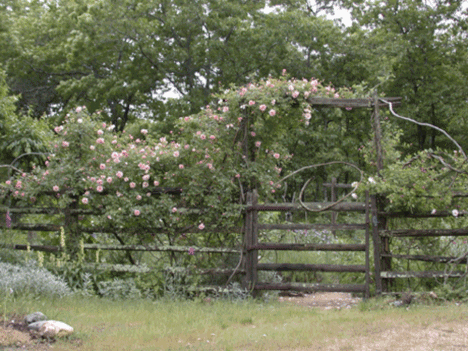
The garden defines a physical space. Painting gives us a manifestation of our mental spaces. We must be completely aware of how we pass from one place to the other. Do we need to struggle over a fence covered in barbed wire? Can we pass easily through a wide-open gate, or do we need to climb over Hegel’s stile to reach the other place? Is the transition from one state to another a gentle one that passes through the feathered edge, or do we find ourselves, like Thoreau, in a frightening wilderness, in stark contrast to civilization? I tried to express this dichotomy in Floating Garden 1 (below, top) representing a walled space, derived from Isel Hall’s magical sunken garden in Cumbria (below, bottom), surrounded by chaotic nature.
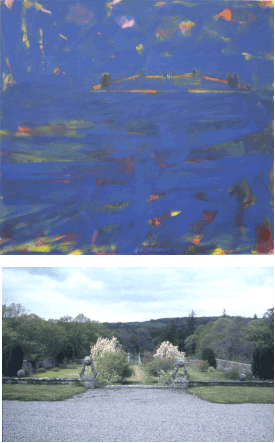 Artists are by nature liminal, marginal, borderline, prone to pass over the edge of what is acceptable in society and, through their transgressions, are often looked on to help define the acceptable. Artists need to be most aware of the meaning of edge. In Friedrich Nietzsche’s first book, The Birth of Tragedy, the philosopher describes the conflict between the Apollonian desire to make forms of pleasing proportion and the Dionysian desire to shatter such forms and “violently transgress the boundaries between the conscious and unconscious, reason and unreason.”[23] During the act of painting, we can experience the mental edges created by the point between the unconscious and the conscious, between the wild and the civilized, between abstraction and representation, and perhaps, as Michel Foucault characterized the dichotomy, between madness and civilization.
Artists are by nature liminal, marginal, borderline, prone to pass over the edge of what is acceptable in society and, through their transgressions, are often looked on to help define the acceptable. Artists need to be most aware of the meaning of edge. In Friedrich Nietzsche’s first book, The Birth of Tragedy, the philosopher describes the conflict between the Apollonian desire to make forms of pleasing proportion and the Dionysian desire to shatter such forms and “violently transgress the boundaries between the conscious and unconscious, reason and unreason.”[23] During the act of painting, we can experience the mental edges created by the point between the unconscious and the conscious, between the wild and the civilized, between abstraction and representation, and perhaps, as Michel Foucault characterized the dichotomy, between madness and civilization.
In 1997 I embarked on a series of paintings (52 Weeks, below) that were an investigation into many of the ideas expressed in this essay.
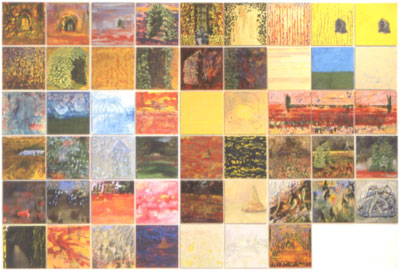
I attempted to interweave additional concepts of time and memory into a visual narrative in which places symbolized experiences of both the moment and the past. I painted a painting a week for a year, and was careful never to go back to a work and not to exceed the seven-day time allotment. Many works were finished at two minutes to midnight on the Sunday! Some were based on my own garden, some on British gardens at Isel Hall (Weeks 22 and 25-27), Powis Castle (Weeks 31 and 46), and Sezincote (Weeks 32, 33, 42 and 49). A few were painted en plein air, but most were painted in the studio. Some images were expressionistic, some cooler and more minimal in treatment. While some are more literal, others are conceptual. In several (Weeks 17-21, 24 [below], 51 and 52), I used the lifeline from my hand to allude to an arbor-like structure.
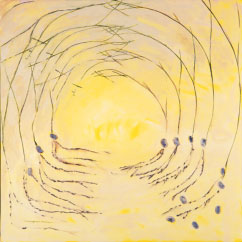 Now that the series is complete, I realize that it has a lot in common with the concepts that inspired it. The reconciliation of order and chaos, as well as the liminal quality of much of the imagery, is evident to me. I also see the ensemble as a kind of conceptual garden made up of many plots, each with its discreet formal arrangement. They may be variations on a repeated theme or unique accents, but their overall unity is only apparent at a distance. As the viewer approaches the work, enters it and wanders through it visually, enjoying its twists and turns, its surprises, and I hope, its pleasures, the garden metaphor is complete.
Now that the series is complete, I realize that it has a lot in common with the concepts that inspired it. The reconciliation of order and chaos, as well as the liminal quality of much of the imagery, is evident to me. I also see the ensemble as a kind of conceptual garden made up of many plots, each with its discreet formal arrangement. They may be variations on a repeated theme or unique accents, but their overall unity is only apparent at a distance. As the viewer approaches the work, enters it and wanders through it visually, enjoying its twists and turns, its surprises, and I hope, its pleasures, the garden metaphor is complete.
– – – – – – – – – – –
Click Here to see the entire series.
This essay is based on THE GARDEN AT THE EDGE: Crossing Hegel’s Stile, an illustrated lecture presented at Winchester College of Art, Southampton University, Winchester, England, in 1999.
NOTES
[1]. Marc Treib, “Sources of Significance: The Garden in Our Time,” in Stuart Wrede and William Howard Adams, eds., Denatured Visions, Landscape and Culture in the Twentieth Century (New York: The Museum of Modern Art, 1991), p. 108.
[2]. Leo Marx, “The American Ideology of Space,” Denatured Visions, p. 66.
[3]. Ian Hamilton Finlay, “Unconnected Sentences on Gardening,” Nature Over Again After Poussin, p. 21, quoted in John Beardsley, Earthworks and Beyond: Contemporary Art in the Landscape. (New York: Abbeville Press, 1984), p. 77.
[4]. John Vernon, The Garden and the Map: Schizophrenia in Twentieth-Century Literature and Culture (Urbana, Chicago, London: University of Illinois Press, 1973), p. 194.
[5]. Leo Marx, The Machine in the Garden: Technology and the Pastoral Ideal in America, (New York: Oxford University Press, 1964). The concept of the pastoral ideal in America is the main theme of Marx’s book, and it is referred to many times.
[6]. Roderick Nash, “American Space,” in James K. Page Jr., ed., The American Land (New York: Smithsonian Exposition Books, 1979), p. 45.
[7]. Marx, “American Ideology,” p. 65
[8]. Ibid., p. 64.
[9]. Nash, The American Land, p. 46.
[10]. Ibid.
[11]. The Works of Joseph Addison, (New York,1855, VI, 337-8), quoted in Marx, The Garden,
p. 93.
[12]. Hunt, Denatured Visions, p. 27.
[13]. Ibid., p.19.
[14]. Beardsley, p. 10.
[15]. Ibid., p. 44.
[16]. From a letter by Gorky reprinted in Ararat, p. 25, included in Kynaston McShine, ed., “Toward the Abstract Sublime: A Selection of Twentieth-Century Artist’s Texts,” The Natural Paradise, Painting in America 1800-1950. (New York: The Museum of Modern Art, 1976).
[17]. Interview between Alan Sonfist and the author, August 14, 1994. All the following Sonfist quotes are from the same interview.
[18]. This information came from a telephone conversation in August 1994 with Larry Penny, Natural Resources Director for the Town of East Hampton.
[19]. Marcel Proust, Cities of the Plain, trans. C.K.Scott Moncrieff (New York: Random House, 1927).
[20]. Written in front of the motif, September 7, 1994.
[21] Donald Kuspit, The Critic is Artist: The Intentionality of Art (Ann Arbor: UMI Research Press, 1984), p. 261.
[22]. Vernon, p. 92.
[23]. James Miller, The Passion of Michel Foucault (New York: Anchor Books, Doubleday, 1993) p. 67.